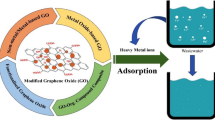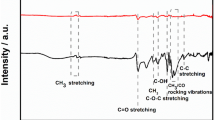Abstract
Current solid-contact ion-selective electrodes (ISEs) suffer from signal-to-noise drift and short lifespans partly due to water uptake and the development of an aqueous layer between the transducer and ion-selective membrane. To address these challenges, we report on a nitrate ISE based on hydrophobic laser-induced graphene (LIG) coated with a poly(vinyl) chloride–based nitrate selective membrane. The hydrophobic LIG was created using a polyimide substrate and a double lasing process under ambient conditions (air at 23.0 ± 1.0 °C) that resulted in a static water contact angle of 135.5 ± 0.7° (mean ± standard deviation) in wettability testing. The LIG–ISE displayed a Nernstian response of − 58.17 ± 4.21 mV dec−1 and a limit-of-detection (LOD) of 6.01 ± 1.44 µM. Constant current chronopotentiometry and a water layer test were used to evaluate the potential (emf) signal stability with similar performance to previously published work with graphene-based ISEs. Using a portable potentiostat, the sensor displayed comparable (p > 0.05) results to a US Environmental Protection Agency (EPA)–accepted analytical method when analyzing water samples collected from two lakes in Ames, IA. The sensors were stored in surface water samples for 5 weeks and displayed nonsignificant difference in performance (LOD and sensitivity). These results, combined with a rapid and low-cost fabrication technique, make the development of hydrophobic LIG–ISEs appealing for a wide range of long-term in situ surface water quality applications.
Graphical abstract








Similar content being viewed by others
References
Mirsky AE, Anson ML (1929) A description of the glass electrode and its use in measuring hydrogen ion concentration. J Biol Chem 81:581–587. https://doi.org/10.1016/s0021-9258(18)63713-5
Lindner E, Tóth K (2009) To the memory of Ernö Pungor: a subjective view on the history of ion-selective electrodes. Electroanalysis 21:1887–1894. https://doi.org/10.1002/elan.200904624
Srinivasan K, Rechnitz GA (1969) Selectivity studies on liquid membrane, ion-selective electrodes. Anal Chem 41:1203–1208. https://doi.org/10.1021/ac60279a014
Shao Y, Ying Y, Ping J (2020) Recent advances in solid-contact ion-selective electrodes: functional materials, transduction mechanisms, and development trends. Chem Soc Rev 49:4405–4465. https://doi.org/10.1039/c9cs00587k
Cattrall RW, Freiser H, Cattrall RW (1971) Coated wire ion selective electrodes. Anal Chem 43:1905–1906. https://doi.org/10.1021/ac60307a032
Michalska A (2012) All-solid-state ion selective and all-solid-state reference electrodes. Electroanalysis 24:1253–1265. https://doi.org/10.1002/elan.201200059
Kałuża D, Jaworska E, Mazur M et al (2019) Multiwalled carbon nanotubes-poly(3-octylthiophene-2,5-diyl) nanocomposite transducer for ion-selective electrodes: Raman spectroscopy insight into the transducer/membrane interface. Anal Chem 91:9010–9017. https://doi.org/10.1021/acs.analchem.9b01286
Guzinski M, Jarvis JM, Perez F et al (2017) PEDOT(PSS) as solid contact for ion-selective electrodes: the influence of the PEDOT(PSS) film thickness on the equilibration times. Anal Chem 89:3508–3516. https://doi.org/10.1021/acs.analchem.6b04625
Yin T, Qin W (2013) Applications of nanomaterials in potentiometric sensors. TrAC - Trends Anal Chem 51:79–86. https://doi.org/10.1016/j.trac.2013.06.009
Wallace GG, Chen J, Li D et al (2010) Nanostructured carbon electrodes. J Mater Chem 20:3553–3562. https://doi.org/10.1039/b918672g
Roy S, David-Pur M, Hanein Y (2017) Carbon nanotube-based ion selective sensors for wearable applications. ACS Appl Mater Interfaces 9:35169–35177. https://doi.org/10.1021/acsami.7b07346
Li F, Ye J, Zhou M et al (2012) All-solid-state potassium-selective electrode using graphene as the solid contact. Analyst 137:618–623. https://doi.org/10.1039/c1an15705a
Ping J, Wang Y, Ying Y, Wu J (2012) Application of electrochemically reduced graphene oxide on screen-printed ion-selective electrode. Anal Chem 84:3473–3479. https://doi.org/10.1021/ac203480z
Justino CIL, Gomes AR, Freitas AC et al (2017) Graphene based sensors and biosensors. TrAC - Trends Anal Chem 91:53–66. https://doi.org/10.1016/j.trac.2017.04.003
Lin J, Peng Z, Liu Y et al (2014) Laser-induced porous graphene films from commercial polymers. Nat Commun 5.https://doi.org/10.1038/ncomms6714
Kurra N, Jiang Q, Nayak P, Alshareef HN (2019) Laser-derived graphene: a three-dimensional printed graphene electrode and its emerging applications. Nano Today 24:81–102
Stanford MG, Zhang C, Fowlkes JD et al (2020) High-resolution laser-induced graphene. Flexible electronics beyond the visible limit. ACS Appl Mater Interfaces 12:10902–10907. https://doi.org/10.1021/acsami.0c01377
Chyan Y, Ye R, Li Y et al (2018) Laser-induced graphene by multiple lasing: toward electronics on cloth, paper, and food. ACS Nano 12:2176–2183. https://doi.org/10.1021/acsnano.7b08539
Secor EB, Prabhumirashi PL, Puntambekar K et al (2013) Inkjet printing of high conductivity, flexible graphene patterns. J Phys Chem Lett 4:1347–1351. https://doi.org/10.1021/jz400644c
Parate K, Rangnekar SV, Jing D et al (2020) Aerosol-jet-printed graphene immunosensor for label-free cytokine monitoring in serum. ACS Appl Mater Interfaces 12:8592–8603. https://doi.org/10.1021/acsami.9b22183
Jin Z, McNicholas TP, Shih CJ et al (2011) Click chemistry on solution-dispersed graphene and monolayer CVD graphene. Chem Mater 23:3362–3370. https://doi.org/10.1021/cm201131v
Soares RRA, Hjort RG, Pola CC et al (2020) Laser-induced graphene electrochemical immunosensors for rapid and label-free monitoring of salmonella enterica in chicken broth. ACS Sensors. https://doi.org/10.1021/acssensors.9b02345
Yagati AK, Behrent A, Beck S et al (2020) Laser-induced graphene interdigitated electrodes for label-free or nanolabel-enhanced highly sensitive capacitive aptamer-based biosensors. Biosens Bioelectron 164:112272. https://doi.org/10.1016/j.bios.2020.112272
Yang Y, Song Y, Bo X et al (2020) A laser-engraved wearable sensor for sensitive detection of uric acid and tyrosine in sweat. Nat Biotechnol 38:217–224. https://doi.org/10.1038/s41587-019-0321-x
Torrente-Rodríguez RM, Tu J, Yang Y et al (2020) Investigation of cortisol dynamics in human sweat using a graphene-based wireless mhealth system. Matter 2:921–937. https://doi.org/10.1016/j.matt.2020.01.021
Cardoso AR, Marques AC, Santos L et al (2019) Molecularly-imprinted chloramphenicol sensor with laser-induced graphene electrodes. Biosens Bioelectron 124–125:167–175. https://doi.org/10.1016/j.bios.2018.10.015
Garland NT, McLamore ES, Cavallaro ND et al (2018) Flexible laser-induced graphene for nitrogen sensing in soil. ACS Appl Mater Interfaces 10:39124–39133. https://doi.org/10.1021/acsami.8b10991
Kucherenko IS, Sanborn D, Chen B et al (2020) Ion-selective sensors based on laser-induced graphene for evaluating human hydration levels using urine samples. Adv Mater Technol 5:1–9. https://doi.org/10.1002/admt.201901037
Bauer M, Wunderlich L, Weinzierl F et al (2020) Electrochemical multi-analyte point-of-care perspiration sensors using on-chip three-dimensional graphene electrodes. Anal Bioanal Chem. https://doi.org/10.1007/s00216-020-02939-4
Umezawa Y, Bühlmann P, Umezawa K et al (2000) Potentiometric selectivity coefficients of ion-selective electrodes part I. Inorganic cations (technical report). Pure Appl Chem 72:1851–2082. https://doi.org/10.1351/pac200072101851
Fibbioli M, Morf WE, Badertscher M et al (2000) Potential drifts of solid-contacted ion-selective electrodes due to zero-current ion fluxes through the sensor membrane. Electroanalysis 12:1286–1292. https://doi.org/10.1002/1521-4109(200011)12:16<1286::AID-ELAN1286>3.0.CO;2-Q
Inagaki M, Ibuki T, Takeichi T (1992) Carbonization behavior of polyimide films with various chemical structures. J Appl Polym Sci 44:521–525. https://doi.org/10.1002/app.1992.070440316
Ni Z, Wang Y, Yu T, Shen Z (2008) Raman spectroscopy and imaging of graphene. Nano Res 1:273–291. https://doi.org/10.1007/s12274-008-8036-1
Pimenta MA, Dresselhaus G, Dresselhaus MS et al (2007) Studying disorder in graphite-based systems by Raman spectroscopy. Phys Chem Chem Phys 9:1276–1291. https://doi.org/10.1039/b613962k
Nguyen VT, Le HD, Nguyen VC et al (2013) Synthesis of multi-layer graphene films on copper tape by atmospheric pressure chemical vapor deposition method. Adv Nat Sci Nanosci Nanotechnol 4:2–7. https://doi.org/10.1088/2043-6262/4/3/035012
He N, Papp S, Lindfors T et al (2017) Pre-polarized hydrophobic conducting polymer solid-contact ion-selective electrodes with improved potential reproducibility. Anal Chem 89:2598–2605. https://doi.org/10.1021/acs.analchem.6b04885
Lamour G, Hamraoui A, Buvailo A et al (2010) Contact angle measurements using a simplified experimental setup. J Chem Educ 87:1403–1407. https://doi.org/10.1021/ed100468u
De Gennes PG (1985) Wetting: statics and dynamics. Rev Mod Phys 57:827–863. https://doi.org/10.1103/RevModPhys.57.827
Vazquez G, Alvarez E, Navaza JM (1995) Surface tension of alcohol + water from 20 to 50 °C. J Chem Eng Data 40:611–614. https://doi.org/10.1021/je00019a016
Bühlmann P, Chen LD (2012) Ion-selective electrodes with ionophore-doped sensing membranes. In: Gale PA, Steed JW (eds) Supramolecular Chemistry, 1st ed. Wiley, New York
Lindner E, Gyurcsányi RE (2009) Quality control criteria for solid-contact, solvent polymeric membrane ion-selective electrodes. J Solid State Electrochem 13:51–68. https://doi.org/10.1007/s10008-008-0608-1
Crespo GA, Macho S, Bobacka J, Rius-Ruiz FX (2009) Transduction mechanism of carbon nanotubes in solid-contact ion-selective electrodes Gasto´n. J Solid State Electrochem 81:676–681. https://doi.org/10.1007/s10008-008-0579-2
Kim HJ, Sudduth KA, Hummel JW (2009) Soil macronutrient sensing for precision agriculture. J Environ Monit 11:1810–1824. https://doi.org/10.1039/b906634a
Lin PKT, Araujo AN, Montenegro MCBSM, Pérez-Olmos R (2005) New PVC nitrate-selective electrode: application to vegetables and mineral waters. J Agric Food Chem 53:211–215. https://doi.org/10.1021/jf049227u
Minero C, Chiron S, Falletti G et al (2007) Photochemincal processes involving nitrite in surface water samples. Aquat Sci 69:71–85. https://doi.org/10.1007/s00027-007-0881-6
Cuartero M, Crespo GA, Bakker E (2015) Tandem electrochemical desalination-potentiometric nitrate sensing for seawater analysis. Anal Chem 87:8084–8089. https://doi.org/10.1021/acs.analchem.5b01973
Radu A, Anastasova-Ivanova S, Paczosa-Bator B et al (2010) Diagnostic of functionality of polymer membrane - based ion selective electrodes by impedance spectroscopy. Anal Methods 2:1490–1498. https://doi.org/10.1039/c0ay00249f
Joon NK, He N, Ruzgas T et al (2019) PVC-based ion-selective electrodes with a silicone rubber outer coating with improved analytical performance. Anal Chem 91:10524–10531. https://doi.org/10.1021/acs.analchem.9b01490
Sundfors F, Lindfors T, Höfler L et al (2009) FTIR-ATR study of water uptake and diffusion through ion-selective membranes based on poly(acrylates) and silicone rubber. Anal Chem 81:5925–5934. https://doi.org/10.1021/ac900727w
Lindfors T, Sundfors F, Höfler L, Gyurcsányi RE (2009) FTIR-ATR study of water uptake and diffusion through ion-selective membranes based on plasticized poly(vinyl chloride). Electroanalysis 21:1914–1922. https://doi.org/10.1002/elan.200904609
Griffiths K, Dale C, Hedley J et al (2014) Laser-scribed graphene presents an opportunity to print a new generation of disposable electrochemical sensors. Nanoscale 6:13613–13622. https://doi.org/10.1039/c4nr04221b
Li B, Fan Y, Huang Y et al (2020) Toward long-term accurate and continuous monitoring of nitrate in wastewater using poly (tetrafluoroethylene) (PTFE)−solid-state ion-selective electrodes (S-ISEs). ACS Sensors 5:3182–3193. https://doi.org/10.1021/acssensors.0c01422
Hu J, Stein A, Bühlmann P (2016) Rational design of all-solid-state ion-selective electrodes and reference electrodes. TrAC - Trends Anal Chem 76:102–114. https://doi.org/10.1016/j.trac.2015.11.004
Bobacka J (1999) Potential stability of all-solid-state ion-selective electrodes using conducting polymers as ion-to-electron transducers. Anal Chem 71:4932–4937. https://doi.org/10.1021/ac990497z
Ping J, Wang Y, Wu J, Ying Y (2011) Development of an all-solid-state potassium ion-selective electrode using grapheme as the solid-contact transducer. Electrochem commun 13:1529–1532. https://doi.org/10.1016/j.elecom.2011.10.018
Hu J, Zou XU, Stein A, Bühlmann P (2014) Ion-selective electrodes with colloid-imprinted mesoporous carbon as solid contact. Anal Chem 86:7111–7118. https://doi.org/10.1021/ac501633r
Paczosa-Bator B, Cabaj L, Piech R, Skupień K (2013) Potentiometric sensors with carbon black supporting platinum nanoparticles. Anal Chem 85:10255–10261. https://doi.org/10.1021/ac402885y
Rousseau CR, Bühlmann P (2021) Calibration-free potentiometric sensing with solid-contact ion-selective electrodes. TrAC - Trends Anal Chem 140:116277. https://doi.org/10.1016/j.trac.2021.116277
Teresa M, Vasconcelos SD, Machado AASC (1988) Effect of temperature on the response characteristics of ion-selective electrodes based on solid silver salts applied to electrically conductive epoxy supports. Analyst 113:49–55. https://doi.org/10.1039/AN9881300049
Han JH, Cui G, Kim SJ et al (2001) Effect of dissolved CO2 on the potential stability of all-solid-state ion-selective electrodes. Analyst 126:2040–2043. https://doi.org/10.1039/b105585m
Dutta S, Sarma D, Nath P (2015) Ground and river water quality monitoring using a smartphone-based pH sensor. AIP Adv 5.https://doi.org/10.1063/1.4921835
Funding
We gratefully acknowledge funding support from the National Institute of Food and Agriculture, U.S. Department of Agriculture, award numbers 2019–05855, 2020–04109, and 2018–672-67016–27578 awarded as a Center of Excellence. The National Science Foundation under award numbers CBET-1706994, CBET-1756999, CBET-1805512, ECCS-1841649, and CMMI-2037026. We also gratefully acknowledge Leigh Ann Long and the Water Quality Research Lab (WQRL) at Iowa State University for analyzing water samples.
Author information
Authors and Affiliations
Corresponding author
Ethics declarations
Conflict of interest
The authors declare no competing interests.
Additional information
Publisher's note
Springer Nature remains neutral with regard to jurisdictional claims in published maps and institutional affiliations.
Supplementary Information
Below is the link to the electronic supplementary material.
604_2022_5233_MOESM1_ESM.docx
Supplementary file 1 Additional SEM images; XPS and Raman spectra ofLIG after the first laser treatment (e.g., hydrophilic LIG); Table of Ramanspectroscopy ID/IG ratios after second laser treatment;Representative CV figure of bare hydrophobic LIG; Representative emf responsefigure; Representative chronopotentiometry response figure; Equations used for electroactivesurface area, capacitance, selectivity coefficients, and activity valuescalculations; Calibration curves in surface water; Table with results fromsurface water sample analysis using EPA analytical method and LIG-ISEs analysis,and Table of comparison of recently published reports on nitrate ISE. (DOCX 1414 KB)
Rights and permissions
About this article
Cite this article
Hjort, R.G., Soares, R.R.A., Li, J. et al. Hydrophobic laser-induced graphene potentiometric ion-selective electrodes for nitrate sensing. Microchim Acta 189, 122 (2022). https://doi.org/10.1007/s00604-022-05233-5
Received:
Accepted:
Published:
DOI: https://doi.org/10.1007/s00604-022-05233-5




